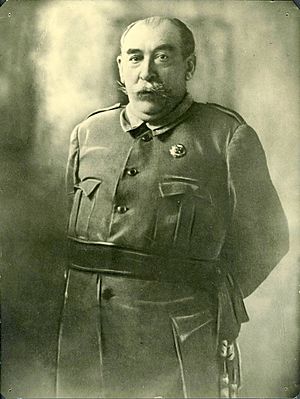Andrés Saliquet facts for kids
Quick facts for kids
Andrés Saliquet Zumeta
|
|
|---|---|
 |
|
| Born | 21 March 1877 Barcelona, Spain |
| Died | 23 June 1959 (aged 82) Madrid, Francoist Spain |
| Buried |
Madrid, Spain
|
| Allegiance | |
| Battles/wars | Spanish–American War Rif War Spanish Civil War |
Andrés Saliquet Zumeta, who was also known as the Marquis of Saliquet, was a Spanish soldier. He was born on March 21, 1877, and passed away on June 23, 1959. He played a part in a military uprising against the Second Spanish Republic. This event led to the start of the Spanish Civil War. During the war, he commanded a group of soldiers called the Army of the Center. This unit included troops from the Tagus River area all the way to Madrid, Guadarrama, and the Universal Mountains.
Contents
Early Life and Military Career
Andrés Saliquet began his military training at the Toledo Infantry Academy. He joined on August 29, 1893, and finished his studies on June 24, 1895. Soon after, he served in the Cuban War of Independence. He also took part in the Moroccan Wars. During these conflicts, he quickly advanced in his military rank.
In 1923, he was promoted to brigadier-general. By 1929, he had become a major-general. During the time when Miguel Primo de Rivera was in charge of Spain, Saliquet was appointed as the civil governor of Santander in 1928. On February 8, 1930, he became the military governor of Cádiz. After the Second Republic was declared, he was removed from his position as military governor.
Role in the Spanish Civil War
Andrés Saliquet had retired from the army. However, he joined a secret plan organized by General Emilio Mola. General Mola asked Saliquet to take command of the VII Organic Division. On July 19, 1936, Saliquet took control of the Province of Valladolid. He declared a state of war there and took charge of the VII Organic Division.
Because of his actions, the Spanish government removed him from the army on July 22, 1936. This was an attempt to stop the military uprising. Saliquet became a member of the National Defense Board. This group was like a temporary government for the rebel areas, based in Burgos. He was also among the generals who chose Francisco Franco to lead the government and the armies. Saliquet continued to command the VII Division, which later became the VII Army Corps.
On June 4, 1937, he was made Commander-in-Chief of the new Army of the Center. This unit was responsible for a large area. It stretched from the Alto Tajo to the Cáceres Front, including Guadarrama, the Madrid Front, and Toledo. At the end of the war in 1939, Saliquet and his units took part in the Madrid Victory Parade. On May 17, he was promoted to lieutenant-general.
Ramón Serrano Suñer, a well-known figure, described Saliquet as "a kind, honest, and good-natured man." He also noted that Saliquet was "very loyal to his commanders."
After the War: Francoist Spain
After the Spanish Civil War ended, Saliquet received new appointments. On July 5, he was made Captain General of the I Military Region, which included Madrid. Later, on July 21, he was put in charge of the II Military Region in Seville. About a month later, on August 19, he was again given command of the captaincy general of Madrid.
In May 1940, Saliquet became a key figure in the new government's administration in Madrid. He signed many official documents related to legal decisions made by military courts. In March 1941, he became the president of a special court. This court dealt with cases related to certain political groups. He held this important position until his death.
During the time of the military dictatorship, Saliquet served as a State Councilor. He was also an Attorney at the Cortes, which was a type of parliament. Between 1945 and 1946, he led the Supreme Council of Military Justice. This happened after he moved to the reserve, as he had reached the age for retirement. He was also given the title of Marquis of Saliquet by Franco.
Awards
- The Military Medal, in 1940.
- Crosses of Military Merit, in 1943.
- Order of Isabella the Catholic, in 1944.
Images for kids
See also
 In Spanish: Andrés Saliquet para niños
In Spanish: Andrés Saliquet para niños


